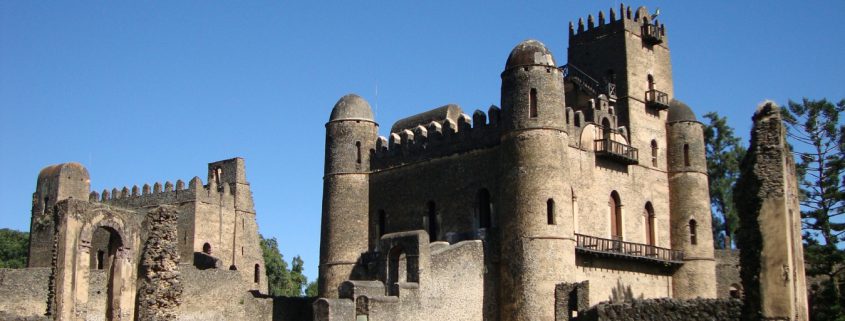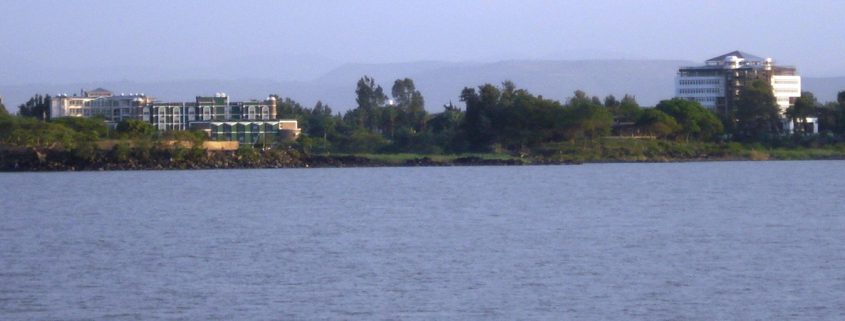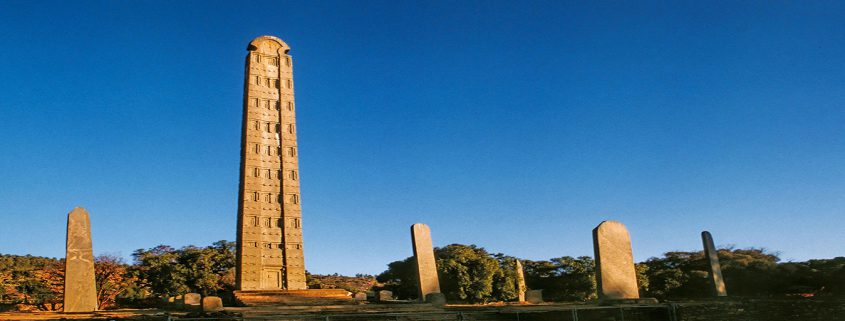GONDAR African Camelot
The Center of Ethiopian art and culture Gondar, founded by Emperor
Fasilidas around 1635, is famous for its many medieval castles and the
design and decoration of its churches – in particular, Debra Berhan
Selassie which represents a masterpiece of the Gondarene school of
art.–Famous though Gondar may be, however, no one knows exactly why
Fasilidas chose to establish his headquarters there. Some legends say an
archangel prophesied that an Ethiopian capital would be built at a
place with a name that began with the letter G. The legend led to a
whole series of sixteenth- and seventeenth-century towns – Guzara,
Gorgora and finally Gondar. Another legend claims that the city was
built in a place chosen by God. Apparently, He pointed it out to
Fasilidas who was on a hunting expedition and followed a buffalo to the
spot. –Flanked by twin mountain streams at an altitude of more than
2,300 meters Gondar commands spectacular views over farmlands to the
gleaming waters of Lake Tana thirty-five kilometers to the south. The
city retains an atmosphere of antique charm mingled with an aura of
mystery and violence. An extensive compound, near its center contains
the hulking ruins of a group of imposing castles like some African
Camelot.
The battlements and towers evoke images of chivalrous knights on
horseback and of ceremonies laden with pageantry and honor. Other,
darker, reverberations recall chilling echoes of Machiavellian plots and
intrigues, tortures and poisonings. –The main castle was built in the
late 1630s and early 1640s on the orders of Fasilidas. The Emperor, who
was greatly interested in architecture – St Marys in Axum was another of
his works – was also responsible for seven churches, a number of
bridges, and a three-story stone pavilion next to a large, sunken
bathing place, rectangular in shape, which is still filled during the
Timkat season with water from the nearby Qaha river.–Other structures
date from later periods. Iyasu the Great, a grandson of Fasilidas, was
particularly active. His castle, centrally located in the main compound,
was described at the time by his chronicler as finer than the House of
Solomon. Its inner walls were decorated with ivory, mirrors and
paintings of palm trees, its ceiling covered with gold-leaf and precious
stones. Now gutted, haunted only by ghosts, the intact turrets and
towers of this fine stronghold reflect its past glory. –Iyasus most
lasting achievement, was the Church of Debra Berhan Selassie, the Light
of the Trinity, which stands, surrounded by a high wall, on raised
ground to the north-west of the city and continues to be in regular use.
A plain, thatched, rectangular structure on the outside, the interior
of Debra Berhan Selassie is marvelously painted with a great many scenes
from religious history. The spaces between the beams of the ceiling
contain the brilliant wide-eyed images of more than eighty angels faces –
all different, with their own character and expressions. The north
wall, in which is the holy of holies, is dominated by a depiction of the
Trinity above the crucifixion. The theme of the south wall is St Mary;
that of the east wall the life of Jesus. The west wall shows important
saints, with St George in red-and-gold on a prancing white horse.–Not
long after completing this remarkable and impressive work, Iyasu went
into deep depression when his favorite concubine died. He abandoned
affairs of state and his son, Tekla Haimanot, responded by declaring
himself Emperor. Shortly afterwards, in 1706, his father was
assassinated on his orders. –In turn, Tekla Haimanot was murdered. His
successor was also forcibly deposed and the next monarch was poisoned.
The brutalities came to an end with Emperor Bakaffa who left two fine
castles – one attributed directly to him and one to his consort, the
Empress Mentewab.



